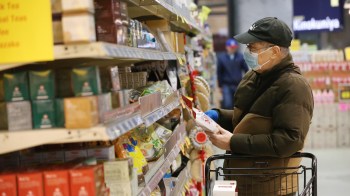The supermarket solution
Kai Ryssdal: If the supermarket industry had its way, we’d all probably only be allowed shop when we’re totally starving and we’d have to leave our grocery lists in the car to encourage random purchases of stuff we don’t really need. Even the most aware shoppers among us aren’t much of a match for marketing geniuses who’ve designed stores for maximum temptation and maximum sales. But what if grocery stores used what they know about us and our buying habits for good instead of evil?
From the Marketplace Health Desk at WHYY in Philadelphia, Gregory Warner reports.
Gregory Warner: From the moment you walk into a grocery store, your path is being plotted. That tower of Pepsi’s you pass five times? That’s no accident. Pepsi paid good rent for that well-traveled bit of real estate at the end of the aisle. Another high-traffic zone is the dairy case. Ever noticed how many other products are clustered around it that aren’t dairy?
Paul Kourtis: It’s all cross-merchandise.
Paul Kourtis is store manager at the Fresh Grocer in North Philadelphia. It’s a supermarket known for bringing fresh produce to low-income areas. But like any store, Fresh Grocer is also trying to sell as much food as possible. So right next to the ever popular dairy case Kourtis stationed the hot dogs. Now he’s got you thinking: cheese dogs.
Kourtis: Yeah. Keep going, you run into your burgers. You got your relishes, your beans, you’re thinking I gotta grill, I got kids coming — you got your Hugs, you got more chips, and you just keep going around!
So you come in for a quart of milk, next thing you know you’re buying burger buns for that barbeque you’ve decided to throw. Every square inch of the store is charted, and every manufacturer is angling for better turf. Into this fray walks Karen Glanz.
Karen Glanz: Hi. Karen Glanz, I’m professor of epidemiology and nursing at the University of Pennsylvania!
Which is a confusing job title because what Karen spends most of her time doing is studying supermarkets.
Glanz: Trying to learn from what commercial marketers have been doing all along, see if we can’t turn that to health advantage.
Glanz has partnered with this store to help rejigger its aisles. And hopefully reprogram shoppers to choose healthier food. For example, people tend to buy what’s on the middle shelf, just because it’s at eye level. And research also shows that when we’re overwhelmed with choices…
Glanz: I mean, there’s a lot of salad dressing out here.
We’re more likely to rely on “shelf-talkers.” Those are those cardboard ads that pop out at you from the shelf.
Glanz: If we wanted to take all the light dressing, move it towards the middle, and call it out with some signage, then somebody might say, “You know, I might try it. I don’t usually get that stuff.”
Here’s another example: Research shows that we’re more likely to choose healthy food when it’s placed right next to its less healthy cousin.
Kourtis: Just put it directly next to it. Right in their face.

Low-fat items next to high-calorie versions. (Credit: Michael Bernstein/Marketplace)
Paul Kourtis the manager has worked here for 15 years. He started pushing carts as a teenager. He told me he was surprised how well this trick worked. He’s used it to sell more whole wheat pizza and more multigrain, low-sodium hoagies.
But follow Glanz’s research all the way and the happy partnership between nutritionist and grocery store marketeer starts to crumble. She says lots studies show that it’s not enough for stores to promote healthy choices — they have to “unsell” the bad stuff.
Glanz: That’s a very tricky proposition. Because no one wants to go against a product.
Kourtis: I mean, nobody wants product to stay on the shelf.
Because no supermarket wants to make any food hard to find. Or lose the high profit on processed food. So other health advocates are pushing for laws restricting where high-fat foods get positioned — with particular focus on the checkout aisle.
Glanz: It’s an aisle that you’re kind of forced through! Unless they go through self-checkout.
Self-checkout doesn’t have the gauntlet of candy bars. Some industry consultant calculated that that an average American woman could lose four pounds a year just going through self-checkout.
Glanz: Self-checkout doesn’t have any of that distraction.
So about that distraction, here’s one more tip: Glanz says we’re more likely to buy something sweet at the end of our shopping trip if we’ve been good about buying healthy the rest of the time. So she says, as you leave the store, treat yourself… to an apple.
In Philadelphia, I’m Gregory Warner for Marketplace.
There’s a lot happening in the world. Through it all, Marketplace is here for you.
You rely on Marketplace to break down the world’s events and tell you how it affects you in a fact-based, approachable way. We rely on your financial support to keep making that possible.
Your donation today powers the independent journalism that you rely on. For just $5/month, you can help sustain Marketplace so we can keep reporting on the things that matter to you.


















